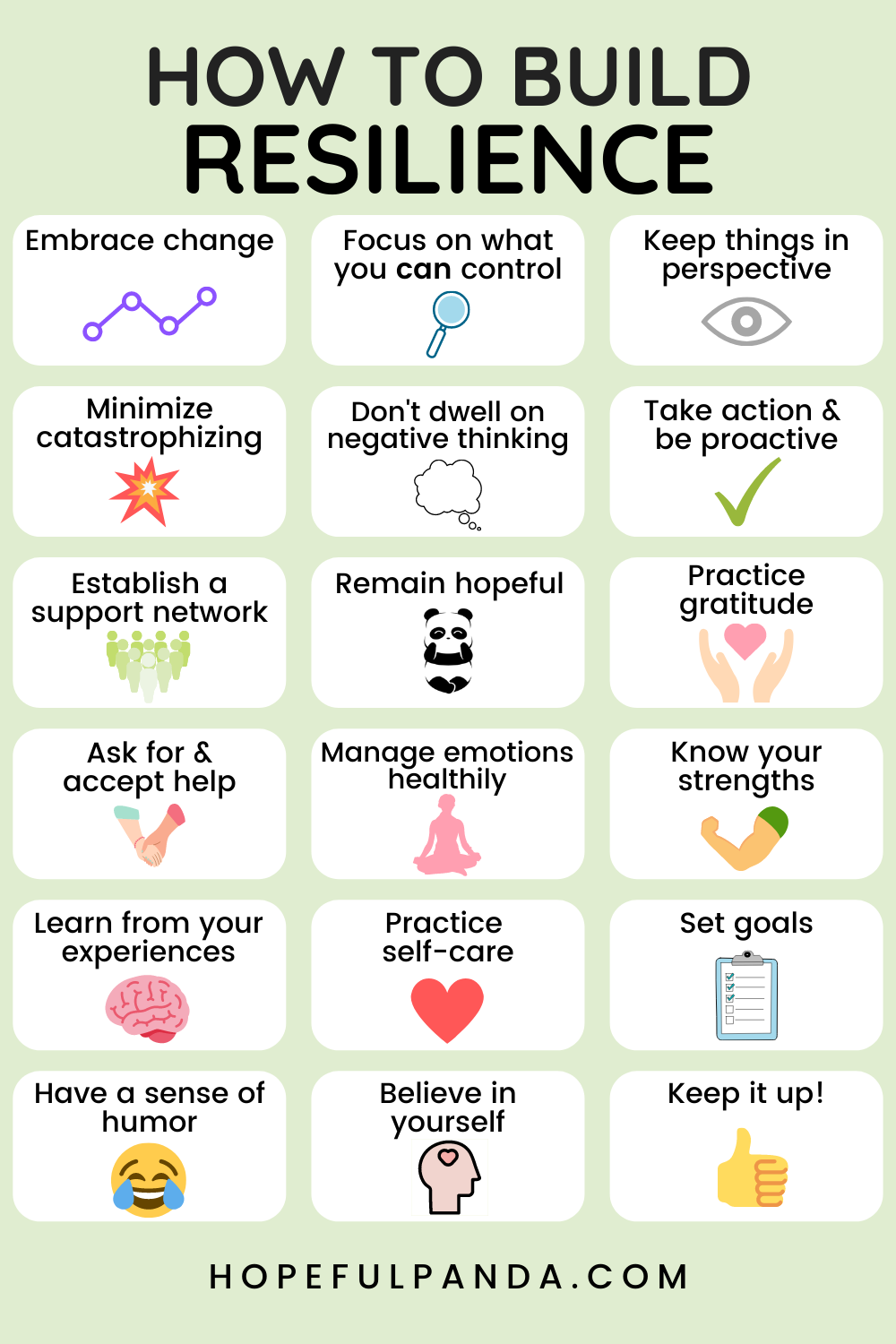Improving Resilience & Mental Health: A Step-by-Step Approach

Table of Contents
Understanding Resilience and its Components
Resilience, in the context of resilience and mental health, is the ability to bounce back from adversity, trauma, tragedy, threats, or significant sources of stress — such as family and relationship problems, serious health problems, or workplace and financial stressors. It's not about avoiding hardship, but about adapting and thriving despite it. Developing resilience is paramount for overall well-being and significantly impacts your mental health. Key components contribute to building strong resilience:
-
Adaptability: This is the ability to adjust to changing circumstances. Examples include learning new skills, embracing flexibility in your plans, and viewing challenges as opportunities for growth. Adaptable individuals are better equipped to handle unexpected events and transitions.
-
Optimism: Maintaining a positive outlook, even during difficult times, is crucial. Practicing gratitude, focusing on solutions rather than problems, and cultivating a hopeful attitude are all key elements of optimism. This positive outlook fuels your motivation and perseverance.
-
Self-efficacy: This refers to your belief in your ability to overcome challenges. Setting achievable goals, celebrating successes (no matter how small), and learning from failures are ways to boost your self-efficacy. This belief in yourself is a cornerstone of resilience.
-
Emotional Regulation: This involves managing and expressing your emotions in a healthy way. Practicing mindfulness, seeking support from trusted individuals, and developing healthy coping mechanisms are vital for emotional regulation. Unregulated emotions can significantly hinder resilience.
-
Problem-solving skills: Effectively tackling challenges and finding solutions requires strong problem-solving abilities. Breaking down complex problems into smaller, manageable steps, seeking advice from others, and brainstorming potential solutions are all essential problem-solving skills.
Practical Strategies for Building Resilience
Building resilience requires conscious effort and consistent practice. Here are some practical strategies:
Cultivating Self-Care Practices
Self-care is not selfish; it's essential for building resilience and maintaining good mental health. Prioritizing self-care involves:
-
Prioritizing sleep hygiene: Aim for 7-9 hours of quality sleep per night. Establish a consistent sleep schedule, create a relaxing bedtime routine, and optimize your sleep environment for better rest.
-
Regular exercise: At least 30 minutes of moderate-intensity exercise most days of the week significantly boosts mood and reduces stress. Find activities you enjoy, whether it's walking, swimming, or team sports.
-
Healthy diet: A balanced diet rich in fruits, vegetables, and whole grains provides the necessary nutrients for physical and mental well-being. Limit processed foods, sugary drinks, and excessive caffeine.
-
Mindfulness and meditation techniques: Regular mindfulness and meditation practice can help reduce stress, improve focus, and increase self-awareness. Numerous apps and resources are available to guide you.
-
Engaging in hobbies and activities you enjoy: Make time for activities that bring you joy and relaxation. This could be anything from reading and painting to spending time in nature or pursuing a creative hobby.
Developing Strong Social Connections
Strong social connections are a powerful buffer against stress and adversity.
-
Building and maintaining supportive relationships: Nurture your relationships with family and friends. Regular communication and quality time are vital.
-
Joining social groups or clubs: Engaging in activities with like-minded individuals provides a sense of belonging and social support.
-
Seeking professional help when needed: Don't hesitate to reach out to therapists, counselors, or support groups if you're struggling. Professional help can provide valuable guidance and support.
-
Communicating openly and honestly: Open communication fosters stronger relationships and helps you access the support you need.
-
Actively listening and providing support to others: Helping others can boost your own sense of well-being and strengthen your social connections.
Managing Stress Effectively
Stress is an inevitable part of life, but learning to manage it effectively is key to building resilience.
Identifying Stressors
The first step in managing stress is identifying your personal stressors. Keep a journal to track your daily stressors, noting the situations, thoughts, and feelings associated with them. Recognizing patterns will help you develop targeted coping strategies.
Implementing Stress Management Techniques
Once you've identified your stressors, implement effective stress management techniques:
-
Deep breathing exercises: Deep, slow breaths can calm your nervous system and reduce feelings of anxiety.
-
Progressive muscle relaxation: This technique involves systematically tensing and releasing different muscle groups to relieve physical tension.
-
Time management strategies: Prioritize tasks, delegate responsibilities when possible, and break down large tasks into smaller, more manageable steps.
-
Setting realistic expectations and goals: Avoid overcommitting and setting unrealistic goals. Learn to say "no" to requests that overwhelm you.
-
Utilizing stress-reducing apps or resources: Many apps and online resources offer guided meditations, relaxation techniques, and stress management tools.
Seeking Professional Help When Needed
Recognizing when you need professional help is a sign of strength, not weakness. If you're struggling with persistent sadness, anxiety, or an inability to cope with daily challenges, seeking professional help is crucial.
-
Recognizing signs that professional help may be beneficial: Persistent feelings of sadness, anxiety, hopelessness, or changes in sleep or appetite may indicate the need for professional assistance.
-
Identifying resources for mental health support: Therapists, counselors, support groups, and helplines offer valuable resources for mental health support.
-
Understanding the benefits of therapy and counseling: Therapy and counseling provide a safe space to explore your thoughts and feelings, develop coping strategies, and address underlying mental health concerns.
-
Overcoming stigma associated with seeking mental health assistance: Seeking professional help is a sign of self-care and should not be viewed with shame.
-
Discussing treatment options with a healthcare professional: A healthcare professional can help you determine the most appropriate treatment options based on your individual needs.
Conclusion
Improving resilience and mental health is a journey, not a destination. By consistently implementing the strategies outlined above – prioritizing self-care, building strong social connections, managing stress effectively, and seeking professional help when needed – you can significantly enhance your ability to cope with life's challenges and cultivate a more fulfilling and balanced life. Remember, strengthening your resilience and mental well-being is an investment in your overall health and happiness. Take that first step today towards improving your resilience and mental health. Start incorporating these techniques into your daily life and experience the positive transformation. Don't hesitate to seek professional help if you need it; improving your resilience and mental health is a worthwhile pursuit.

Featured Posts
-
 Dow Futures And Dollar Decline After Moodys Action
May 21, 2025
Dow Futures And Dollar Decline After Moodys Action
May 21, 2025 -
 Nagelsmann Selects Goretzka For Nations League Tournament
May 21, 2025
Nagelsmann Selects Goretzka For Nations League Tournament
May 21, 2025 -
 Bundesliga Mainzs Dramatic Turnaround Against Leipzig Thanks To Burkardt And Amiri
May 21, 2025
Bundesliga Mainzs Dramatic Turnaround Against Leipzig Thanks To Burkardt And Amiri
May 21, 2025 -
 Matt Lucas And David Walliams Cliff Richard Musical A Potential Problem
May 21, 2025
Matt Lucas And David Walliams Cliff Richard Musical A Potential Problem
May 21, 2025 -
 El Regreso De Javier Baez Salud Y Rendimiento
May 21, 2025
El Regreso De Javier Baez Salud Y Rendimiento
May 21, 2025
